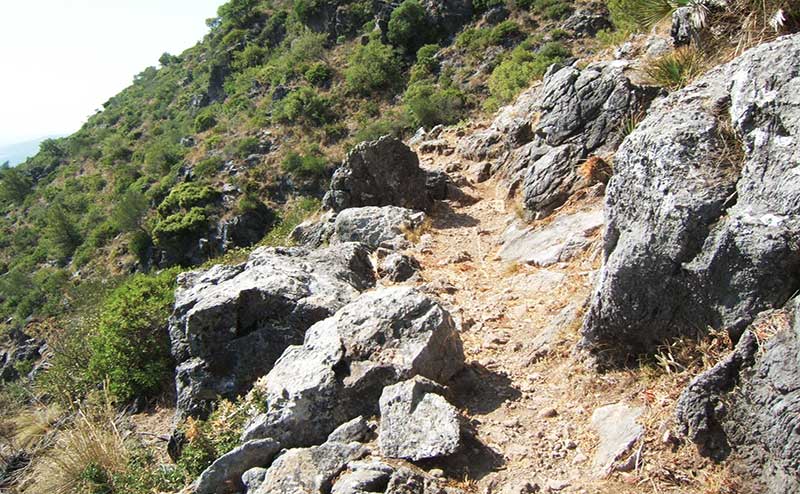Those of you who live outside the province of Malaga will think that this title is clickbait or that there is some kind of mistake. Is there a hiking circuit and various natural sites in Malaga to enjoy nature beyond sun and beach tourism?
The answer is yes. In Malaga there are up to six natural sites where you can experience a real adventure connected with the great outdoors.
In order for an area to be considered a Natural Site, several factors must be fulfilled, such as being unique enclaves due to their geological singularity or biodiversity. Within this spectrum we can find areas ranging from gorges with depths of 100 metres, limestone mountain ranges or areas with abundant native flora and fauna.
The 6 natural sites of Malaga are divided into five districts and are located in remote parts of the region. Grab your rucksack, put on suitable footwear and comfortable clothes, and let’s get to know them.
GORGE OF THE GAITANES
Known for crossing the famous Caminito del Rey and rising like a limestone wall from the Guadalhorce river, this gorge of Jurassic dolomites is one of the most unique places in the province for its geomorphological value.
Thanks to the footbridges hanging on its walls at a height of 300 metres, it is possible to walk along a distance of 3 km. Don’t worry about vertigo. The place is very stable and complies with all safety measures since its reopening by the Junta de Andalucía.
Another alternative route goes from the Conde de Gualdalhorce dam for about 5 kilometres to the Desfiladero.
The flora of the Desfiladero de los Gaitanes is made up of several endemic species (some of which have adapted to their vertical lifestyle). The most characteristic are the black juniper, holm oaks, Mediterranean scrub and Aleppo pine forests.
In terms of fauna, there is a good variety of birds of prey, including the peregrine falcon, the eagle owl and the Bonelli’s eagle. In the high limestone areas of the gorge we can see the mountain goat, golden eagle and griffon vulture, as well as the white-capped blackbird and the swift. In the adjacent lands, the grey heron and the dipper stand out.
Genets, wild boar, mongoose and martens also roam the area. The Desfiladero de los Gaitanes was declared a Natural Site on 18 July 1989 and has been classified as a Special Protection Area for Birds (SPA) since 2000.
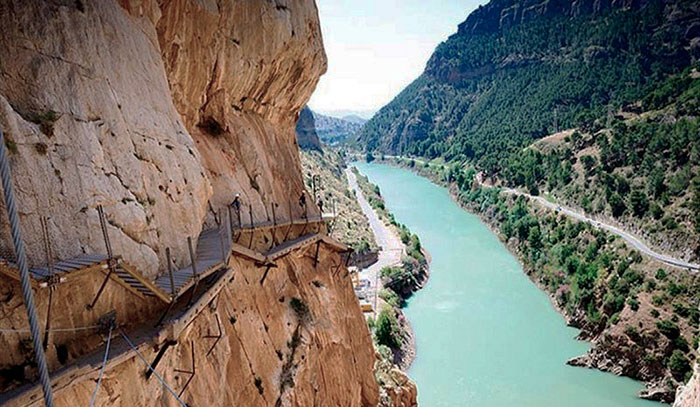
CRESTELLINA MOUNTAIN RANGE
One of the best natural sites in Malaga is the Sierra Crestellina. It is located in the western municipality of Casares, in the area bordering the province of Cádiz, and covers 477.5 hectares. The area gets its name from the orography of its ridges.
One of its peculiarities and attractions is that, thanks to its 900 metres of altitude, it is possible to have beautiful views of the coast and the Strait of Gibraltar. If we want to visit this beautiful natural spot we cannot miss the pretty white village of Casares and its particular fountain of Carlos III.
Its formation is made of limestone rock with a greyish colour and its overall appearance and relief is so characteristic that Sierra Crestellina Mountain Range was declared a Natural Site on the same date as the Desfiladero de los Gaitanes, 18 July 1989.
It is also notable for its endangered species of flora. Some of the most representative are cork oaks, gall oaks, holm oaks, pines, junipers and kermes oaks.
As for the fauna, we can find griffon vultures (Gyps fulvus), Egyptian vultures (Neophron percnopterus), Bonelli’s eagles (Aquila fasciata), peregrine falcons and eagle owls.
There are hiking trails in Crestellina Mountain Range; one of them links the “Puerto de las Viñas” pass with the mountain refuge that exists in the area. From the viewpoint we can appreciate incredible views of the western area of the province up to beyond the province of Cádiz, glimpsing the “Campo de Gibraltar” or the Genal Valley.
It is possible to spend the night in the mountain refuge for 30 €, which is increased by 5 € for groups of three or more. At the foot of the mountain there is a famous cheese factory with a local goat’s cheese called “payoya”, which can be bought at an affordable price.
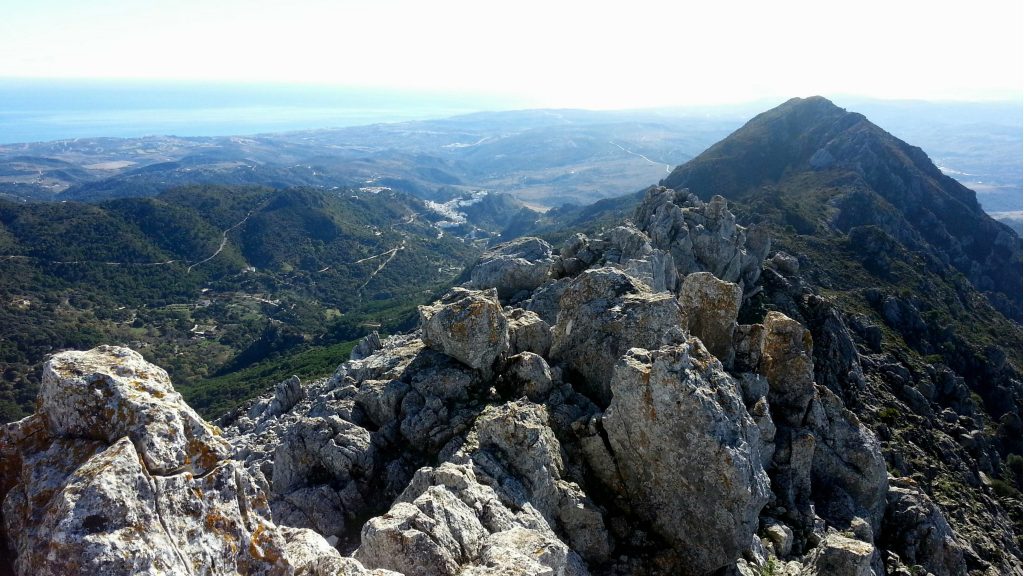
THE TORCAL OF ANTEQUERA
We have already spoken previously in Malaka Turismo about the Torcal de Antequera Natural Park, as this particular environment with its capricious mineral forms, is the enclave where the Dolmens of Antequera were built during the Neolithic period.
It is located in the central area of the province of Malaga, between Antequera and Villanueva de la Concepción, with an extensive surface area of 2,180 hectares. It is also one of the best examples of karst landscape in Europe, due to the water erosion suffered by its torcas or dolines. In the process, they are filled with decalcification clay, called terra rossa.
It belongs to the Subbetic group – which runs from Cádiz to Jaén – connecting the Campo de Gibraltar with the “Sierra Morena”. Much of its flora is endemic, such as the linaria anticaria and oblongifolia, saxifraga biternata, viola demetria, among others. The main vegetation in Torcal is holm oak, but there are also gall oaks, rowan and maple trees.
Griffon vultures are once again present in El Torcal as a bird endemic to Mediterranean climates; we will also find other species such as eagle owls, little owls, kestrels, black and black-eared wheatears, red-billed choughs and other smaller birds.
There are two routes through the area: Green and Yellow, which will start from the Visitor Centre at the entrance to the site, but also the one that starts at the part of the car park that overlooks the road and links Antequera with Villanueva de la Concepción.
The Torcal de Antequera was declared a “Natural Site of National Interest” in 1929, being the first place in Andalusia to be a Protected Natural Area. In 1978 it was declared a Natural Park.
As a curiosity, El Torcal de Antequera sits on the now extinct Tethys Sea; in fact, there are still visible some ammonites or marine fossils that may be 200 million years old.
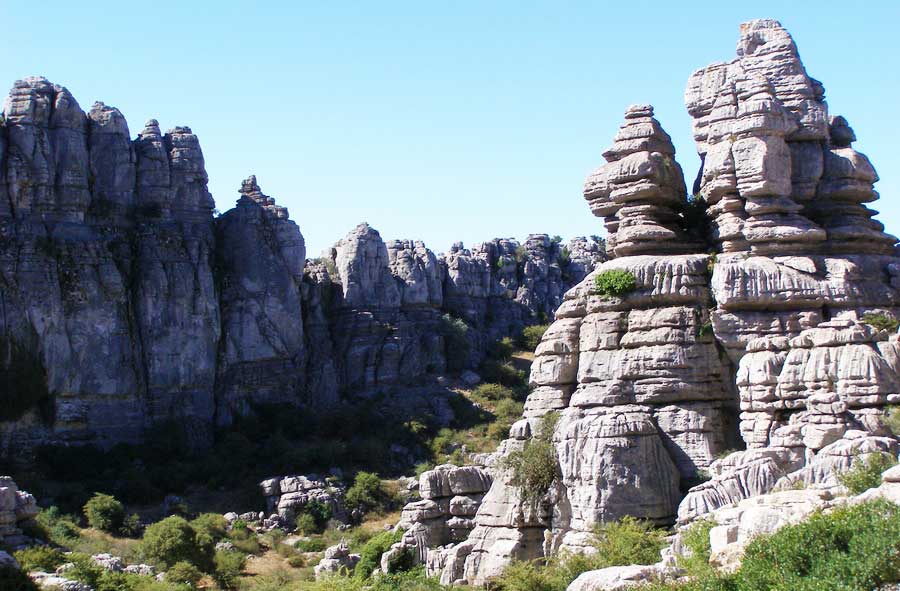
LOS REALES DE SIERRA BERMEJA
We move to the southwest of the Serranía de Ronda, in the municipalities of Casares, Estepona and Genalguacil, to find the Paraje Natural de Los Reales de Sierra Bermeja.
This area of 1,236 hectares is recognised by the scientific community for being one of the enclaves with the highest concentration of ultrabasic rocks called peridotites, which are associated with the Alpujarran units of the Inner Zones of the Betic Cordilleras.
What is so important about this tongue twister? The geochemistry of these volcanic soils favours the proliferation of one of the most characteristic ecosystems in Andalusia. We are talking about the pinsapar, which is home to around fifty endemic species spread over 90 hectares.
The flora of this particular enclave abounds in resin pine, juniper, strawberry tree and cork oak. As for the fauna, the golden eagle, the peregrine falcon and the eagle owl are joined by other smaller birds such as the crossbill, the wheatear and the Alpine accentor.
There are several hiking routes in Los Reales de Sierra Bermeja. The first starts from the road that passes through the natural area and crosses an extensive forest of Spanish firs until it reaches what is known as the Plaza de García Lorca. If you are a lover of the poet from Granada, you can read some of his verses scattered among the surrounding trees.
There is another route through the area to reach the summit of the sierra or Pico de los Reales. From a distance of 1,450 metres above sea level we can enjoy stunning views of the area.
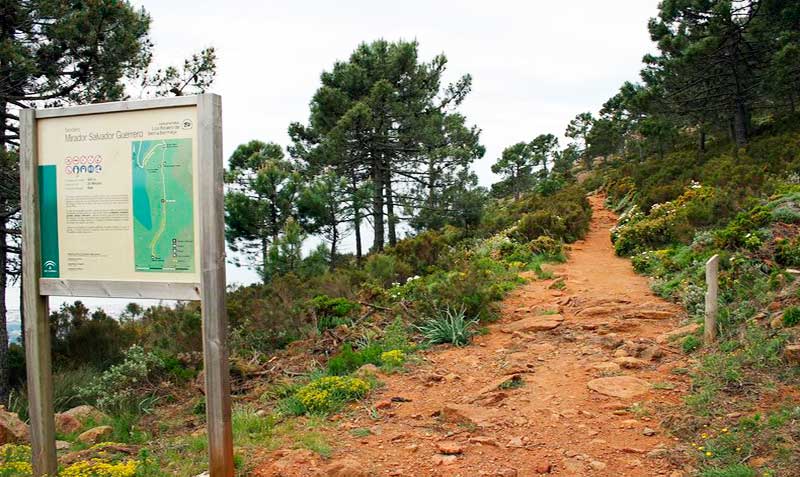
MARO-CERRO GORDO CLIFFS
In the eastern part of Malaga and bordering the province of Granada, we find the Maro Cliffs (in Nerja), and Cerro Gordo, (Almuñecar, in Granada). Among the 6 natural sites in Malaga, this one has the particularity of being the only one located on the coast.
For those in the know, when you hear Maro, you will know that we are also on one of the most beautiful and hidden beaches in the province of Malaga thanks to its biodiversity. But it is much more than that. The natural site that is located in this area has a total surface area of 1,913 hectares (384 hectares of land and 1,529 hectares of sea surface).
The steep cliffs of Maro are 75 metres high, with a row of coves stretching from Sierra de Almijara in Almuñecar to Nerja in Malaga. Here there are two endangered endemic species such as the Malaga evergreen evergreen and the white rosemary, as well as the Balearic boxwood and the hawthorn.
The sea mile is home to unique species of flora and fauna such as Posidonia oceanica, Zostera marina and Zostera nodosa, which create a seabed prone to the spawning of a large number of fish and which is included in the list of Priority Habitats by the European Union due to its importance.
In Maro there are local companies with which we can snorkel and move among corals, anemones, molluscs and a large amount of marine life. There is a population of orange coral, considered an endangered species.
These companies can also take us to visit some of these caves, such as the Cajilla cave. Among the varieties of fish we can find we can mention the grouper, the moray eel or the conger eel.
A beautiful route that will undoubtedly accompany us with all the sea breeze of the east of the Costa del Sol.
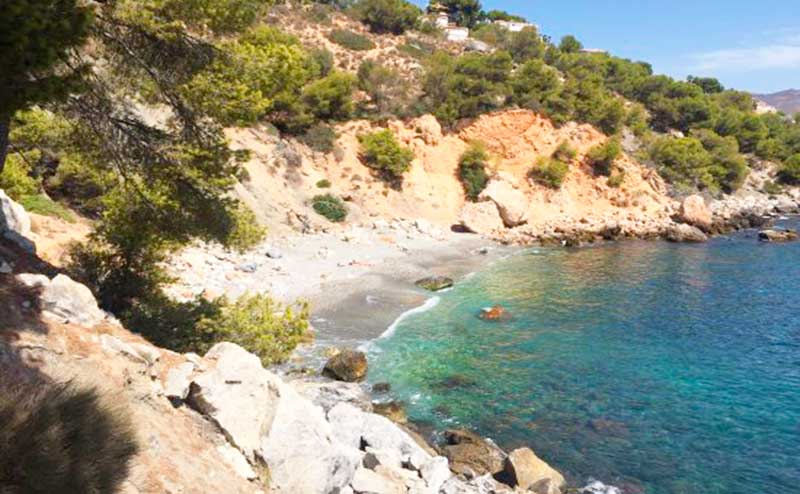
MOUTH OF THE RIVER GUADALHORCE
Having wandered around the province, it is time to stay in the city of Malaga and discover another of the province’s Natural Sites. Its proximity to the city is undoubtedly one of the most characteristic aspects of this area, but this does not detract from its virtues as an area of great ecological value.
Its extension, located in the southern part of the city, is relatively small in comparison with the places we have been describing. Only 67 hectares in the area known as “Finca de la Isla”, between the two branches of the Guadalhorce river.
The main value of this lagoon complex is that it is a breeding and nesting site for up to 250 species of birds. If we want to enjoy the migration season, this usually takes place during the months from spring to autumn.
There are many species of booted eagles and ospreys, herons, flamingos, squids, white-headed duck, pochards, buzzards, cormorants and the beautiful black stork. The accessibility to this place through the Gran Senda de Málaga, makes this enclave a treasure for birdwatching lovers and even for walking with children.
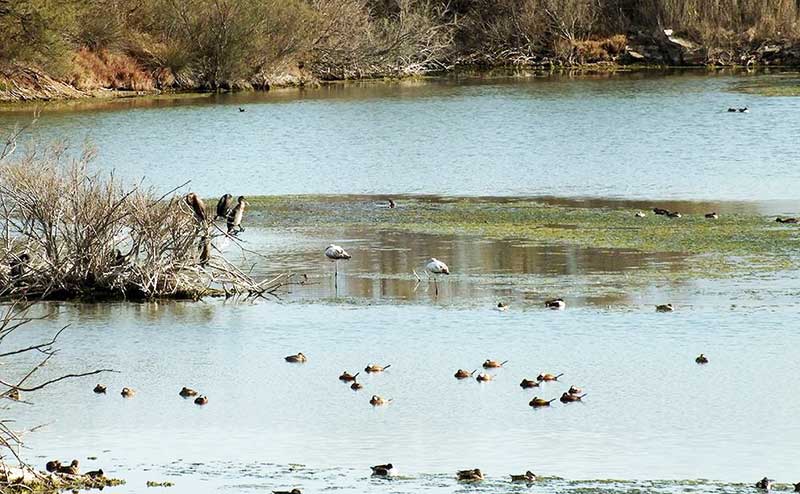
The best thing about it is that, being next to the city, it is possible to get there by bicycle and even, after visiting the site, to walk to a nearby beach bar to taste some of the best espetos in the city.
In the following posts we will be telling you about different routes through these natural landscapes individually. In the meantime, don’t miss them!
– FEATURED POSTS-

